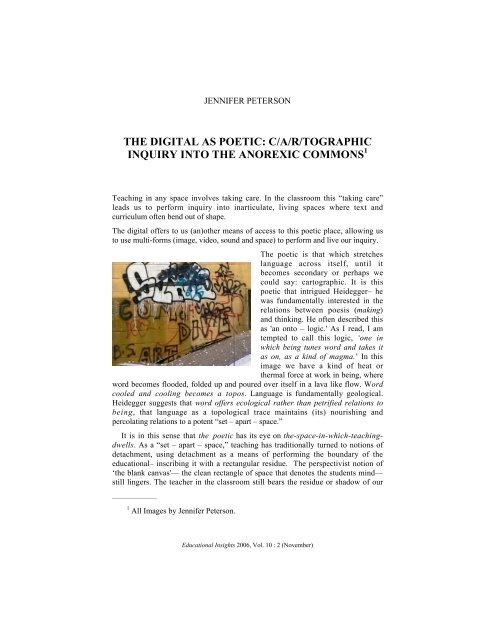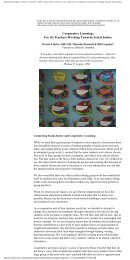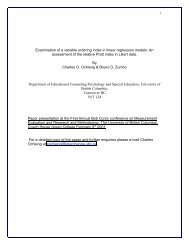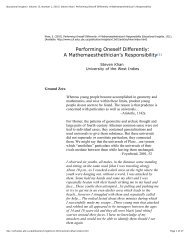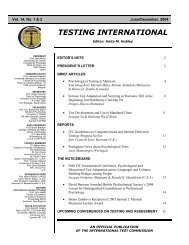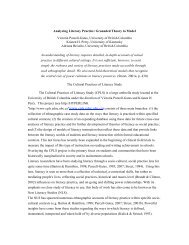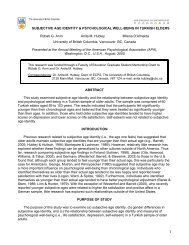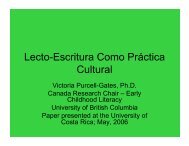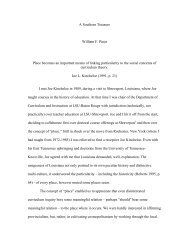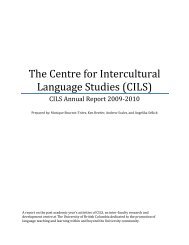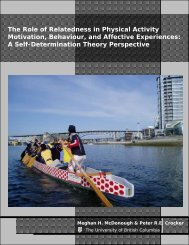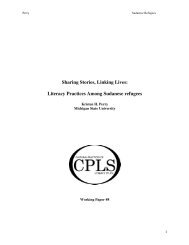Educational Insights 2006, Vol. 10 : 2 | JENNIFER PETERSON | THE ...
Educational Insights 2006, Vol. 10 : 2 | JENNIFER PETERSON | THE ...
Educational Insights 2006, Vol. 10 : 2 | JENNIFER PETERSON | THE ...
You also want an ePaper? Increase the reach of your titles
YUMPU automatically turns print PDFs into web optimized ePapers that Google loves.
<strong>JENNIFER</strong> <strong>PETERSON</strong><br />
<strong>THE</strong> DIGITAL AS POETIC: C/A/R/TOGRAPHIC<br />
INQUIRY INTO <strong>THE</strong> ANOREXIC COMMONS 1<br />
Teaching in any space involves taking care. In the classroom this “taking care”<br />
leads us to perform inquiry into inarticulate, living spaces where text and<br />
curriculum often bend out of shape.<br />
The digital offers to us (an)other means of access to this poetic place, allowing us<br />
to use multi-forms (image, video, sound and space) to perform and live our inquiry.<br />
The poetic is that which stretches<br />
language across itself, until it<br />
becomes secondary or perhaps we<br />
could say: cartographic. It is this<br />
poetic that intrigued Heidegger– he<br />
was fundamentally interested in the<br />
relations between poesis (making)<br />
and thinking. He often described this<br />
as 'an onto – logic.' As I read, I am<br />
tempted to call this logic, ‘one in<br />
which being tunes word and takes it<br />
as on, as a kind of magma.’ In this<br />
image we have a kind of heat or<br />
thermal force at work in being, where<br />
word becomes flooded, folded up and poured over itself in a lava like flow. Word<br />
cooled and cooling becomes a topos. Language is fundamentally geological.<br />
Heidegger suggests that word offers ecological rather than petrified relations to<br />
being, that language as a topological trace maintains (its) nourishing and<br />
percolating relations to a potent “set – apart – space.”<br />
It is in this sense that the poetic has its eye on the-space-in-which-teachingdwells.<br />
As a “set – apart – space,” teaching has traditionally turned to notions of<br />
detachment, using detachment as a means of performing the boundary of the<br />
educational– inscribing it with a rectangular residue. The perspectivist notion of<br />
‘the blank canvas'— the clean rectangle of space that denotes the students mind—<br />
still lingers. The teacher in the classroom still bears the residue or shadow of our<br />
––––––––––––––<br />
1 All Images by Jennifer Peterson.<br />
<strong>Educational</strong> <strong>Insights</strong> <strong>2006</strong>, <strong>Vol</strong>. <strong>10</strong> : 2 (November)
<strong>PETERSON</strong><br />
long affair with ‘the page’ and ‘the book’. The rectangular room with its rows, the<br />
fresh white space of the overhead and screen, often function in the classroom as a<br />
kind of 'upheld space', a sacred kind of square. Much of the topography of the<br />
classroom is penetrated by notions of space as organized and penetrated by the<br />
coordinates of the linear and the smooth surface of the page. As a topological<br />
surface, curriculum at times becomes an effort to accumulate geological densities<br />
through (thick) acquisitions of page(s). Perhaps we hope reading and writing lines<br />
of the text might become a space to perform the self, amidst the rhythm of rows,<br />
numberings, (ac)countings and rankings. All of these perform a means of locating:<br />
they help us’ locate-us”– as kind of self/other relation where an imaginary of<br />
pages— boxes, frames, charts, graphs,<br />
maps— order our relations, performed as a<br />
container.<br />
We create this fiction– a fiction that has<br />
always been troubled by curves, because we<br />
need it. Particularly as educators– it has<br />
allowed us to understand, to scaffold, to step<br />
outside and view the learning situation from<br />
an imagined distance. This has enabled us to<br />
draw some of important and potent lines, lines<br />
that trace our acts of teaching and negotiate<br />
with its deciduous nature.<br />
Bie Dao’s (1994) poetics were forged in relations between education and the<br />
trauma spaces of Tiananmen Square. He argues that we find it necessary in life to<br />
evoke “forms of distance” (p. 19, poem entitled Corridor). But we also need a<br />
complement, an engagement of the counter pose. 2<br />
As the digital has often been used to complement the linear urges of educational<br />
endeavors, I have been seeking a counter pose. I have been asking, how can the<br />
digital be used to account for teaching as a peculiar immersion into space?<br />
We experience education in an acoustic space 3 , in which bells, trash collection,<br />
––––––––––––––<br />
2<br />
David Hinton writes of Bei Dao (whose poems surface and thicken consonant with<br />
the surfacing and thicken that which is/was Tiananmen Square): “his poems are constructed<br />
from splinters of a civilization frittering itself away in a ruins of the spirit, and at the same<br />
time in the private space they create, the poems open forms of distance from those ruins” (p.<br />
vii).<br />
3<br />
Acoustic space is a concept made popular by Walter Ong (1982) and Marshall<br />
McLuhan (1962) following their predecessors, Eric Havelock and Harold Innis. It is roughly<br />
determined by the relations marked out by sound and presence, as they mark media and are<br />
marked out by a media: The distinctive sensorial configuration being hearing and the limits<br />
of the human voice (as opposed to visual space, which is marked out by the visual).<br />
In oral societies this relation was direct. Sound and word were not conceived of as<br />
separate. In ancient cultures text is an idea that can’t to a certain extent be thought. Word as<br />
a visual— as a read/viewed ‘thing’— comes late into culture. Word was predominantly<br />
(continued)<br />
18
loudspeakers, students entering and exiting,<br />
interrupt, puncture and seem to defer curricular<br />
plans. “Being’ bends educational goals into<br />
graffiti, marking them with curvaceous excess.<br />
Our students, (and our emotions) sometimes<br />
appear before us written where we did not plan,<br />
interrupting our educational space like letters<br />
smeared big onto walls.<br />
When margins invade their frames we are at<br />
the place of poetic opportunity.<br />
DIGITAL AS POETIC<br />
When during my graduate work, some one turned and placed a digital camera in<br />
my hand. I felt surprise, the delight of the weight of this camera placed into my<br />
hand, as a clue to my own gravity. I began to use the camera and my hands to glean<br />
images in concert with thinking and reading — forming (my) images of (my) world<br />
differently in this way. As I did this, I began to experience (what I would later<br />
describe) ‘a new sense of agency” (and re/new/ed sense of urgency)… I began to<br />
forge a different (embodied) connection to my gaze.<br />
In trying to figure out why this was so, I turned to my old, thick and beloved<br />
Oxford English Dictionary, last revised in 1957. I looked up the word digital to<br />
trace its etymology. Of course I found no trace of our recent (yet now common)<br />
sense of this word, as the products and projects of binary code. Rather I found this<br />
definition: “pertaining to the fingers, the toes” (and sometimes indicative of the<br />
products of hand and foot that connects these)…also as in designating value…as<br />
marked by the symbolic numerical (digit).”<br />
Haunted by the residue of the body that is imbedded in this definition, I decided<br />
to practice a conversation— a pose and counter pose— between this older idea of<br />
digital and more recent connotation of digital. I challenged myself to occupy the<br />
space of a maker in relation to the digital.<br />
––––––––––––––<br />
understood for some time (until print really) as connected to a speaker and to hearing.<br />
Performed word (in which breathing configures reading, reading occurs in community)<br />
evokes the idea of presence, and body as the resonant space of breath. Thus presence as<br />
resonance and consonance marked all aspects of reading, especially marking it (until quite<br />
recently, as a communal act).<br />
Acoustic space in many ways is what marks the classroom as a culturally unique space.<br />
The classroom remains one of the few/view places where reading and learning happen in<br />
conjunction with a communal presence and a direct relation to the boundaries of the human<br />
voice. Its communal spaces thus appear marked by some older forms of orality and media<br />
relations: and these as relations with community and knowing as co-formed events.<br />
19
<strong>PETERSON</strong><br />
This was a new and awkward pose (for me). I adopted it intentionally hoping<br />
this unfamiliar postural exchange with these two digitals would extend and twist<br />
me into an imbedded network of sensual relations, especially those between<br />
fingers, toes, body and (its)postural and gestural workings regarding interchanges<br />
with screen, keyboard, scanner,<br />
camera (and their occasioning of<br />
art, craft, media and<br />
technology). I practiced this<br />
digital conversation quite<br />
literally for some time.<br />
For example, I challenged<br />
myself to draw pictures of my<br />
hands. Then I took these into the<br />
screen (via camera or scanner). I<br />
then 'worked’ these images on<br />
screen. I often printed out these<br />
worked images and modified<br />
them, frequently writing on<br />
them. I often tore and ripped<br />
these images, all the while<br />
endeavoring to notice not just<br />
my hands but also the<br />
positioning of my body and feet<br />
in relation to these images.<br />
A thermal exchange accrued. While making images of my hand was laborious,<br />
something happened as I bent to view them in the camera lens. The postures I had<br />
to assume to capture these images included all sorts of bowing and hovering. When<br />
these surfaced on the screen (so close to my heart area)– I recorded maternal kinds<br />
of (odd) reactions and attachments.<br />
I found myself challenged to take my making<br />
seriously– to listen to it the way I would a<br />
child’s. This process built upon itself and upon<br />
a charged and refractive capacity of the screen.<br />
It became quest like. It was then that wrote in<br />
my journal: This digital conversation between<br />
digital and digits leads me on as if I am<br />
engaged in a kind orienteering. I have become<br />
intense, as if I am breaking new and important<br />
ground in a kind of bewildering and intriguing<br />
cartographic journey.<br />
I later tried to clarify this notion of the cartographic, which hand appeared<br />
mysteriously in my journal:<br />
20<br />
The digital enables this merging of writing, image and form, so that writing
DIGITAL AS POETIC<br />
expands into a ‘graphy” 4 This ‘graphy’ beckons a keening of writing, image<br />
(and the mix of other forms) as play and flow in representational structures.<br />
Graphy seems to denote (as a suffix of many words)— the flow of form into<br />
a kind of mapping. It allows a performing of its object(subject)/subject<br />
(object) 5 as relations, It leans not as much to explanation, verification, debate,<br />
justification and/or (at times even) narrative but instead enables a honing/an<br />
allowing/ and a pointing towards— an expanse.<br />
This seems to me, to be an effort at a kind of cartography. This hint of<br />
cartography that ‘graphy’ allows, also seems to be particularly porous to<br />
aesthetic form and flow. It can attune (especially) to relations between<br />
process and representation. In such ‘graphy’- space and its percolations into<br />
form— appear to become primary— or we could even say ‘primal’– They<br />
become particularly alchemizing to meaning. 6<br />
I tested these observations with teacher practitioners in urban environs. I gave<br />
them cameras and sent them off to research their environments while at the same<br />
time encouraging them to position themselves in a conversation as (poetic<br />
inquirers, makers and observers). We engaged in making and the digital spaces 7<br />
––––––––––––––<br />
4 I am grateful to A/r/tography’s recognition of this idea of ‘graphy.’ Also hint of<br />
these relations comes from Irit Rogoff’s (2000) work and from Richard Cavell’s (2002)<br />
writings on Marshall McLuhan and space.<br />
5 I don’t believe that there ever is an object (without a subject, or subjective residues) or<br />
a subject (without its objects and objective residues). One or the other becomes a primary<br />
modality or foci in our activities of representation particularly their binary forms.<br />
Subject/object are folded acts of representational efforts, particularly when the sentence is<br />
employed as our productive means of assembling ideas and knowing. Acts of writing, direct<br />
us to subject/object particulars that have evolved a certain kind of directionality based on the<br />
folding of actualities into the dimensions of our grammars of representation.<br />
6 From my Ph.D. thesis: Excavating Barbie\Excavating Me: Digital Making (my)<br />
Inarticulate Space - an Intimate Study of the Digital, p. viii.<br />
7 I started off by theorizing poetic inquiry for this purpose. From my journal October<br />
2003: “poetic inquiry is, like any inquiry, a means of inquiring into. It is like any inquiry, a<br />
means of peering, a commitment to lingering longer, or as Heidegger would put it– to dwell<br />
with. Poetic inquiry finds the deep spaces, our centrifugal tensions, marginalized glances,<br />
fleeting residues, memories that make our being dense. Poetic inquiry brings the body, the<br />
pause, the gap, the rip, the breakage forward for a be/holding.<br />
This bending of language into an architectural, a space that circles its own subject and<br />
marks its edge as a threshold is what poetry does. It stretches text and image open, sculpts<br />
and performs it as space. Poesies lingers with meaning as sensual– it brings language to its<br />
alter (othering), in the spatial, the tactile; the momentary, the fleeting tangible, the un-uttered<br />
space.<br />
The poetic lays down alphabet in order to penetrate the spaces between words, to<br />
re/create these and to let them they linger together breathing. The poetic attends to the<br />
struggle to bring forth that which is primary, focal, and needs to be presenced from that<br />
which is absented, erased and pushed to the margin.”<br />
21
<strong>PETERSON</strong><br />
mainly through learning to produce movies. As we watch the final cut of their<br />
movies, together, there often accrues an attachment to these<br />
projects. This attachment is profound but is somewhat bewildering<br />
to an ‘outside’ viewer. These teachers appear to enter a space of<br />
‘entrancement’ 8 around their own projects, becoming strangely<br />
transfixed by them. One could say that this becomes a<br />
thresholding 9 — a powerful, intimate and difficult to word—<br />
space. Offered to a part of the self that teachers often cannot locate<br />
a container for, this digital becomes a poetic alchemy. It bubbles<br />
up an offer of a space to attend to both self and other. As self/other<br />
(relations) are where educational opportunity often treads and, as<br />
the poetic above all requires, a self, poesis + digital seems to offer<br />
the teacher a cartography— a means of rewriting and repositioning the<br />
topographical relations between themselves and their environs.<br />
This repositioning is possibly the result of bewilderment, <strong>10</strong> a particularly<br />
important and potent educational space. Poesis is rumored to be particularly fond<br />
of bewilderment as a ‘ be – wild – space.’ McKay argues that be – wild – er - ment<br />
often needs an aesthetic space and uses aesthetic space in order to re/cognize<br />
knowing.<br />
I am intrigued by the digital practiced as a kind of poetic c/a/r/tographic<br />
inquiry: An inquiry that opens into a conversation between virtuality and actuality.<br />
This ‘digital’ seems to heat up as it is recognized and noticed. By using the word<br />
digital here I again re/mark (as the pose and counter pose) the digital as body<br />
(digits as in fingers/feet) and digital (as in digital binary code). The digital allows<br />
curriculum to screen back in to its squared spaces: image - space - poetry - music -<br />
dance - costume - color - even graffiti. This access to multiple forms for appearing<br />
––––––––––––––<br />
8 en/ trance/ ment: I theorize this as a means of foraging entry and presence into virtual<br />
spaces. Trance is an entry into an imaginal form performed by as a response to<br />
actual/architectural/structure embeded in media as cues to habitized set of gestural,<br />
artifactual and topographical interchanges. We are used to this entrancement, as how we<br />
enter the space of the book. (We pick it up, turn it right side up, open to the correct page by<br />
certain glances to certain areas in its lay out or topography. We bend over it. We hold its<br />
weight in our palms, etc.) We are often bemused by the entrancements activated by clicks &<br />
screen. We are often bemused by our students’ failures to enter the entrancements of the<br />
book as performative/knowing/spaces.<br />
9 Thresholding – the means where by something is entranced in to a space (also at the very<br />
same time the means where some (other) things are not entranced into a space)<br />
<strong>10</strong> Bewilderment as used here is borrowed from the work of several poets whose work is<br />
gathered by Tim Lilburn (1995) in the volume entitled Poetry and Knowing. I appropriate<br />
several of their fruitful pauses, but most directly Don McKay’s work. Wilderness as<br />
developed by McKay “ “is the capacity of all things to elude the mind’s appropriation” (p.<br />
21), and “poetic attention” as a form of attunement to this wilderness in a form of<br />
“ontological applause” (p. 24).<br />
22
DIGITAL AS POETIC<br />
allows the digital to offer a means of poetic access, an honoring of the (s)places 11<br />
that text exceeds, that it struggles to word– but needs body to re/present.<br />
I borrow here from a/r/tography, which was developed within art education. 12<br />
A/r/tography can be described as an effort to engage with intention and attunement,<br />
the sticky and fertile relations between texts, artifacts, images, sound and<br />
performances not just as products of the gaze– but as making. A/r/tography attends<br />
to a certain conversion of the space of<br />
looking into the space of making<br />
(poesis). It attends to this ‘making<br />
space’ as a magma space of the<br />
complex topographies of the artistmaker/researcher/teacher.<br />
In<br />
envisioning poesis as a bodily practice<br />
of making that combines knowing<br />
(theoria) and doing (praxis),<br />
a/r/tography offers curriculum a<br />
theorizing of a kind of ever moving<br />
lava-like positionality that is able to<br />
threshold the cartographic as an<br />
autographic possible.<br />
* * * * *<br />
To simplify, we can return to our caricature of the three squares: the page, the<br />
screen and the classroom. These squares mark our cultural topography, imprinted<br />
as imaginary (even meteorological) residues. These squares become particularly<br />
potent for educators, and students, for the fecund liminal space they<br />
form/negotiate and experience habitually (one could even say ritually) together. 13<br />
Insomuch as these squares echo and form a practice of the commons as the<br />
collective possible, these three squares can (each in their own way) form hard or<br />
––––––––––––––<br />
11 (s)place as a term that combines place and space as an orientating event, which is<br />
from Lynn Fels’ (1999) performative inquiry.<br />
12 Originally developed by Rita Irwin, Stephanie Springgay, Alex de Cosson, Sylvia<br />
Kind, Wendy Stephenson and others (Irwin & de Cossen, 2004).<br />
13 Limen: “The frontier, the margin, the border between one thing and another, between this<br />
and that, known and unknown, knowable and unknowable may be called the limen. The<br />
limen is a ‘a fructile chaos, a fertile nothingness, a storehouse of possibilities, a striving after<br />
new forms and structures’ (Turner, cited by Aoki, Low & Palulis, 2001). Liminars are<br />
people who live with/in this fecund limen, existing in a ‘threshold state ‘betwixt and<br />
between borders’ (Norton 1988, p. 53; Pryer, 2004).<br />
23
<strong>PETERSON</strong><br />
soft edges. Because of its location in the inhabitized<br />
14 world of the burgeoning child, the<br />
classroom ‘square’, especially, becomes a<br />
container of this autographic/collective<br />
(private/public) possible.<br />
The digital, with its access to multi-form(at)s is<br />
already leaky. It opens up the screen as an osmotic<br />
possibility for the I, particularly the I that needs to<br />
appear and disappear, the I that needs to acquire<br />
masks, the I that needs to acquire alternative sensory and sensual landscapes in<br />
order to process ‘as a view.’ Consumptive topographies specialize in reigning in<br />
this screening, directing it to agentive channels of gaze, consumption and purchase.<br />
‘School’ has proven (often) amenable to these muted agentive relations, enjoying<br />
in the cultivation of ‘page’, a certain specular complement to these ‘screened<br />
relations.’<br />
These relations linger in the shadows, not just as a desire for a quiet<br />
reader/eater/ sitter/watcher (and of late, buyer), but as a phantasmagorical longing<br />
for the (Newtonian) fixed viewer. This is the viewer(s) whose commentary from<br />
seated spaces is configured into to the civic space as participation. The classroom<br />
still retains its discomforts with the square of the screen, but is still hopeful<br />
regarding the cultivations of (seated) commentaries. It is still often lured into to the<br />
wishing for watchers who while remaining seated, nevertheless lean into civic<br />
space through a kind of thinking/viewing/saying (which is signaled by the raised<br />
hand). This idealized viewer is perhaps one that engages in critical commentary of<br />
a made world, activating in the classroom, through the participatory gesture of the<br />
question. This longed for raised hand, that of the interested student, slows down a<br />
temptation to switch the channel (the ultimate technological specular gesture). In<br />
this mode, entertainment becomes intertwined as a consumptive agent in a<br />
commons that elevates agency into acts of purchasing. Thus this question as act,<br />
often lingers at the edges of commerce with objects but<br />
falters regards the commerce of actual (not<br />
phantasmagorical) subjects (which is complex and leaky).<br />
The screen in this scenario becomes infographic but not<br />
necessarily c/a/r/tographic.<br />
24<br />
The educator often appears here entangled in various<br />
versions of this phantasmagorical longing. Possibly forced to<br />
appear as its gapped space, especially as ‘I’ empty. Teachers<br />
are often made to appear as the phantoms of this infographic.<br />
They are submitted to the scrutinies of a ghosted<br />
––––––––––––––<br />
14 Play on habitized (or habitus ) from P. Bourdieu: the web like sense of place that forms<br />
and is formed by the relations between spaces, perceptions and repetitive patterned activity<br />
(particularly that which is ritualised) which functions as a structuring for meaning and space<br />
in social collectives.
DIGITAL AS POETIC<br />
commerce/commons merger, one that wants the to deal with objects and values,<br />
not subjects (as valued). The notion of the screen and the page as space for ‘an<br />
appearing I’ to learn to appear (and to learn also to disappear) stuns some<br />
members of the civic who have inscribed certain roles as absence. Insomuch as<br />
educators have been taught to practice their absence as the means for the student<br />
(or object) to appear, curriculum reifies the consumptive I of the student (or<br />
object). Insomuch as the teacher is unable to practice having an I, the teacher<br />
attempts to practice an impossible weightlessness in the square of the classroom.<br />
This weightlessness is bound to collapse (with the teacher or student or the<br />
classroom itself often appearing as the gapped space). This attempted weightless<br />
“I” presides over the mix of students who seek a guide, and whose cartographic<br />
actualities may be such that they imitate, dilate, reject and abject this<br />
weightlessness. 15 Insomuch as curriculum is practiced as the continuous activity of<br />
mind, body becomes the gap. Body becomes the topographic that is forced to<br />
appear outside the margins, creating the classroom, page and screen as anorexic<br />
spaces in regards to ‘I’ and ‘ body,’ scrutinizing them vigorously for a thinness of<br />
the commons.<br />
If such a mind is to become agentive regards representations and their relations<br />
to the I/Other relations embedded in private/public topographies, they need a return<br />
of (Don McKay’s) be-wild space. 16 Be-wild marks again being and the wild as<br />
––––––––––––––<br />
15 I play with Julia Kristeva’s (1982) idea of the abject. I play it out as a meaning play<br />
in which forgetting/remembering become entangled (particularly with the projective, which<br />
becomes entangled in the linguistic). It is a process that is entangled with the<br />
making/unmaking/remaking of identity. Thus, where language operates by differentiation.<br />
Kristeva observes a ‘semiotic’ differentiation that pushes up against the symbolic ordering<br />
of world, in a primordial way. This is the oceanic-amniotic unity of body/sensory/knowing<br />
that precedes and undergirds language. This play works in part by thrusting up/pushing<br />
forth an identity (foregrounding) by playing against a forgetting (backgrounding). For<br />
example, land-implies and also forgets ocean in order to appear (symbolically) as land. It is<br />
this identity edge where the horrific monsterous lingers – as for example when oceans tidal<br />
waves land appearing generously where it should not appear at all.<br />
16<br />
This dyad of I/Other was once practiced in western culture as a theological<br />
topography in which Other (as God/the transcendent) was identified as ‘set-apart-up/lifted<br />
up’ and ‘I’ was the trouble that prevented access to this transcendent. This map changed at<br />
many points, but for this essay we could mark the spot when Other (God/the transcendent)<br />
was barred from civic space in order to form the commons. Descartesian thinking could be<br />
described as the effort to replace the “I am’ side of the dyad (‘I am being the<br />
Hebraic/Christian formula for God) with the (thinking, rational and disembodied) “I am.”<br />
There was also replacement of Other for other, other subbing in for ‘the troubling I’ of this<br />
theological dyad. In the civic commons: the mix is such that subjective I/other/body<br />
becomes confused and fused together as the trouble of the commons. Purification (in many<br />
cases) becomes an important civic/shared commons project, and thus the identification of<br />
other by body and by body-typing efforts (including object/subject-typing). In theorizing a<br />
poetic/cartographic space, Other assembles as a need for a ‘poetic naming’ of the ‘not-I’<br />
(continued)<br />
25
<strong>PETERSON</strong><br />
topographic and organic forms. These forms (which<br />
are always in the process of forming) interiorize the<br />
logic of their growth in fashions that are not easily read<br />
panoptically. The panoptic, Foucault notes, is a view<br />
that becomes installed culturally (and often invisibly)<br />
as a prison. The panoptic view is installed in the tower.<br />
The prison is organized to expedite the view from<br />
above and all is reworked for exposure. In educative<br />
versions of this, the mind is often oblated and the body<br />
problematic. The mind is in education, the territory<br />
bearing the hope of the (ideal) public commons. And<br />
yet (as prisoners know), the mind is the least exposed<br />
in this view-intensive scenario. It can be concealed. It<br />
is the body that is exposed/ vulnerable/fragile to<br />
panoptic view, difficult to hide. The body bears the<br />
brunt of panopticism. There is a temptation on both the<br />
part of the teacher and student, coming (perhaps) from different motivations, to<br />
practice body as muted and docile.<br />
Yet, the screen is also culturally appropriated here to mimic and mine this need:<br />
The act of ‘I-ing through choice’ accruing through purchase or click (especially).<br />
These dynamics allow I and the body to appear as artifactual (as hidden in<br />
art/I/fact).<br />
It is in this way that the educative is especially naive. It hopes in the visual<br />
dynamics of the classroom which would enable a fruitful visibility of the learner.<br />
Thus the square of the classroom (and its complement in the square of the page and<br />
screen) have been maximized to allow the exposure of the learner as a topography.<br />
This hope in the birds-eye (tower) viewer – in the teacher trying to map a<br />
curriculum often results in a transposition of the panoptical view into the (child’s)<br />
habitual experience of the public square. It can be experienced as a kind of<br />
overexposure – a too much sun relation to knowing. The ‘I’ whose learning/needs<br />
are ‘forming’, ‘cooling’, ‘stratifying’, ‘folding’, ‘fault-lining,’ ‘gaping’, ‘seeding’,<br />
‘composting,’ ‘ incubating,’ ‘shading,’ and ‘veiling,’ get sunburnt. They wilt<br />
under this exposure, often seeking cover in order to form, feeling caught ‘in view’<br />
––––––––––––––<br />
space, the poetic (or poesis) being that which seeks a naming that does not violate I or<br />
Other. Both words are capitalized in my work as an attempting to mark a Thou-Thou<br />
relationality that attends representation, particularly as as ‘set-apart/lifted up’ space.<br />
Representiation is that effort which (when it deals in binaries, as it often does) needs to be<br />
made by both (I/Other). Accounting (both), valuing (both): both as (weighed<br />
heavy/potent/self-defining, agentive) compassing points. I recommend chasing both I &<br />
Other down, marking them as fault-lines/plumb-lines in civic space. I particularly<br />
recommend making sure both appear respected, given space for making and remaking<br />
(civic)space. I certainly recommend both practiced as present (equitably and agentively) into<br />
the various squares (classroom, page and screen) that resonante into public space.<br />
26
DIGITAL AS POETIC<br />
of the strong interrogative that often accompanies educative endeavors. There is<br />
also another phantasmagorical hope – as exposure lingers – that the student would<br />
surface as almost already formed (i.e., not needing much intervention from the<br />
tower).<br />
Thus, poiesis (making) is used to interrupt curriculum as producing a specular<br />
commons and the poetic calls for the<br />
interruption of squares (books,<br />
classroom, screens), with ourselves:<br />
Our selves as messy (perhaps).<br />
Ourselves as fissures (perhaps).<br />
Ourselves as immersed in an ecology<br />
of made world(s) that are always being<br />
remade. Poiesis is my way of marking<br />
and calling for the actuality of the<br />
commons and its made-ness: madeness<br />
being our everforming and<br />
unforming topological conjunction(s)<br />
with our appearings and<br />
disappearings. Poiesis asks in accord with the Heideggerian concern: When does<br />
curriculum substitute in for pedagogy, a petrified technological circuit around the<br />
ecology of the made? How can curriculum seek ecological rather than petrified<br />
relations to being? When and where does curriculum become topological, a<br />
mapping that maintains its nourishing and percolating relations to the actual/potent<br />
“set – apart – space” that marks the I, the Educator, the Other in their common<br />
relations?<br />
To reiterate, I advocate a digital (which is practiced as body and mind) as a<br />
fecund limen of virtual and actual that locates the agentive ‘making and remaking’<br />
of representational space as an active remaking of actual and virtual relations.<br />
I advocate a poetic (a making cultivated as respectful, nourishing and<br />
vocational) redress of gap(s) and be wild space(s). I recommend the poetic as a<br />
counterpose to the panoptic, a counterpose particularly attuned to that binary<br />
I/Other, particularly I/Other as makers and remakers of private/public spaces,<br />
especially attending to spaces in which I/Other virtualites emerge and are weighted<br />
(against) the gravities of actualities.<br />
I advocate a c/a/r/tographic (currere practiced as making, thinking, agency) as<br />
inquiry into I/Other topographies, including those that exist as relations between<br />
educator and educatee, especially those that cultivate representation as agentive<br />
space and cultivate the commons as agentive, fertile and fecund.<br />
These advocacies are offered as counter pose, as the bend away from habitual<br />
positions and assimilated geometries, particularly those that assemble speculative<br />
audience/ viewer/ consumptive relations.<br />
The classroom is a sort of last ideation bearing the residues of the commons<br />
27
<strong>PETERSON</strong><br />
appropriated to democracy, increasingly a democracy disappearing into screens<br />
and/or shopping malls, purchasing and clicks as the action of citizenry. I advocate<br />
‘a lurching in’ the educational, a loping into the space of the screen as its maker not<br />
just viewer. I advocate ‘a lurching in’ into the space of text as its ‘lava -like’ fissure<br />
(not just its lurking invisible I hiding out from contracts formed by g(l)aze).<br />
I mention performative inquiry alongside a/r/tography as another educational<br />
inquiry effort that attempts a tilling/fertilizing complement to rethinking the<br />
classroom commons. These methodologies together give educators tools for<br />
remodeling, reimagining and remaking the territorialization of the cartographic /<br />
autographic possible. 17 Performative inquiry complements a turn to art (which the<br />
digital enables through its public access to multi-sensory, multi-formal means of<br />
re-imagining). Yet art itself is a territory that is territorialized. It is bound up in the<br />
many cultural dynamics that construct the canvas as oblated, as a square watched<br />
and critiqued, and too often practiced as unattainable to us and school. This has a<br />
long complex history.<br />
Performative inquiry 18 imagines an educational practice of welcome, the<br />
classroom as an always deciduous, composting and decomposing shape or<br />
‘square.’ It imagines us as primordial to the mechanisms of representation,<br />
acknowledging invitation as resistance to a ‘basic ‘othering’ mediated by the<br />
technological spectre, a spectre that works to<br />
secure powers through delineating acts of<br />
representation into genealogies of viewer/maker<br />
lineages.<br />
––––––––––––––<br />
17 Note the word terror in territory. I make this plea for the agentive ‘I’ and ‘the<br />
commons’ in a time when ‘terror’ has come to dominate the consumptive/specular as an<br />
attempt at bewilderment. Contradicting ‘terrorization’ requires a curricular space that is<br />
more than speculative in order to unfold topographically, c/a/r/tographically and critically<br />
into spaces that are alternatives to consumption, watching and as action as weapon.<br />
18 In performative inquiry, the student is invited to perform their questions and to form<br />
them alongside and in collaboration with other performances. This idea of the performative<br />
as a slippage into posture(s), as doing shape(s) or shaping(s), I get from Lynn Fels (1999). I<br />
am inspired by her definition(s) of performative inquiry in her dissertation: “a (re)search<br />
methodology, possibilities and absences within a space moment of imagining a universe."<br />
28
DIGITAL AS POETIC<br />
Performative inquiry is thus an example of a cartographic compliment to all<br />
educational efforts at mapping<br />
curricula, in so much as it offers the<br />
invitation to (fall) into the map, into the<br />
fault lines of its squares (of the screen,<br />
page and classroom) into the remaking<br />
of their problematic power spots. It<br />
does this by turning to the fissure<br />
“where that camera/paint brush/stage is<br />
held.’ This invitation into the hot center<br />
of specular configuration, undoes a<br />
positioning which is often manifest in<br />
complex hierarchies around who is<br />
maker and who is viewer/critic of the<br />
making. By inviting ‘watchers’ into<br />
and out of to the square of making to make (believe) and unmake (believe) the<br />
square (as say a vortex), performative inquiry exemplifies another way to unmake<br />
the panoptical tower, and to remake the boundaries of the specular, permeable to<br />
participation and to play. It re-emphasizes a generosity towards making that pushes<br />
knowing up against the boundaries of specular desires.<br />
Education as a producer of commons is arrested in a certain disembodied turn and<br />
we as bodies are uncomfortable when our body reappears in its ‘set-apart’ squares.<br />
We feel shame, a desire to conceal our bodies as no/bodies. We need incubative,<br />
generous and generative spaces in order to regain and practice our innate literacies<br />
regarding body/mind as a commons. We need to learn to become comfortable with<br />
reuniting body and mind as our cartographic actuality. Technography will<br />
intervene here in various (often ingenious) ways as the desire for this clumsy<br />
body/mind combo to vanish. No message is perhaps more powerful for the<br />
commons than the insistence of only “attractive appearances.”<br />
To conclude, I return to a scenario mentioned earlier of educators gathered together<br />
to occupy the screen with their own gathered/made and edited images. As their<br />
videos were uplifted into this squared space, they felt emphasized. I want to<br />
emphasize the importance of the educational as a topographical invitation, of its<br />
potency regards the hot (confusing) centers of ‘its’ entrancing squares and their<br />
role in collecting and activating I’s. Education can remake its collective: As a<br />
learned/learning space, as in/formation, as a space permeable to the I engaging as<br />
an “I?/ Other?’<br />
This fertile I?/ Other? re/dis/appears as ‘us’ in the commons, as contradictions<br />
with/in a commons (being) made, remade, reduced and seduced— as powerful<br />
possible.<br />
29
<strong>PETERSON</strong><br />
30<br />
REFERENCES/BIBLIOGRAPHY<br />
Aoki, T. T., Low, M.. & Palulis, P. (2001). Re-reading metonymic moments with/in living<br />
pedagogy. Paper presented at the American <strong>Educational</strong> Research Association Annual<br />
Meeting. Seattle, WA.<br />
Cavell, R. (2002) McLuhan in space: A cultural geography. Toronto: University of Toronto<br />
Press.<br />
Dao, B. (1994). Forms of distance, poems by Bei Dao (trans D. Hinton). New York: New<br />
Directions Books.<br />
Fels, L. (1995). In the wind clothes dance on a line: Performative inquiry— a (re)search<br />
methodology: possibilities and absences within a space-moment of imagining a universe.<br />
Unpublished dissertation. University of British Columbia.<br />
Lilburn, T. (Ed.). (1994). Poetry and knowing. Kingston, ON: Quarry Press.<br />
Irwin, R. & de Cossen, A. (Eds.). (2004). A/r/tography: Rendering self through arts-based<br />
living inquiry. Vancouver: Pacific <strong>Educational</strong> Press.<br />
Kristeva, J. (1982). Powers of horror: An essay on abjection (trans. L. S. Roudiez). New<br />
York: Columbia University Press.<br />
Mcluhan, M. (1962). Gutenberg galaxy: The making of typographic man. New York: New<br />
American Library.<br />
Norton, A. (1988) Reflections on political identity. Baltimore: John Hopkins University<br />
Press.<br />
Ong, W. (1982). Orality and literacy: The technologizing of the word. New York:<br />
Routledge.<br />
Pryer, A. (2004). Living with in marginal spaces: In R. Irwin & A De Cossen (Eds.),<br />
A/r/tography: Rendering self through arts-based living inquiry. Vancouver: Pacific<br />
<strong>Educational</strong> Press.<br />
Rogoff, I. (2000). Terra infirma: Geography's visual culture. New York: Routledge.<br />
AFFILIATIONS<br />
Jennifer Peterson, Ph.D. Candidate<br />
Department of Curriculum Studies,<br />
University of British Columbia


